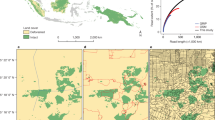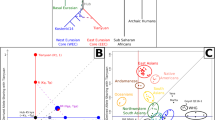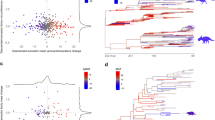Abstract
Despite over a century of archaeological research, the nature and broader consequences of Maya warfare remain poorly understood. Classic period (250–950 ce) Maya warfare has largely been viewed as ritualized and limited in scope1,2,3,4,5,6. Evidence of violent warfare in the Terminal Classic period (800–950 ce) is interpreted as an escalation of military tactics that played a role in the socio-economic collapse of the Classic Maya civilization7,8. The implications of specific textual references to war events (war statements) remain unknown, however, and the paucity of field data precludes our ability to test collapse theories tied to warfare. Here we connect a massive fire event to an attack described with a Classic period war statement. Multiple lines of evidence show that a large fire occurred across the ancient city of Witzna, coincident with an epigraphic account describing an attack and burning of Witzna in 697 ce. Following this event, evidence shows a dramatic decline in human activity, indicating extensive negative impacts on the local population. These findings provide insight into strategies and broader societal impacts of Classic period warfare, clarify the war statement’s meaning and show that the Maya engaged in tactics akin to total warfare earlier and more frequently than previously thought.
This is a preview of subscription content, access via your institution
Access options
Access Nature and 54 other Nature Portfolio journals
Get Nature+, our best-value online-access subscription
$29.99 / 30 days
cancel any time
Subscribe to this journal
Receive 12 digital issues and online access to articles
$119.00 per year
only $9.92 per issue
Buy this article
- Purchase on Springer Link
- Instant access to full article PDF
Prices may be subject to local taxes which are calculated during checkout





Similar content being viewed by others
Data availability
All charcoal, physical property, pollen and age control data from the sediment core will be archived in the National Centers for Environmental Information Fire History database (https://www.ncdc.noaa.gov/data-access/paleoclimatology-data/datasets/fire-history). Archaeological reports, photographs and excavation drawings are available at https://www.bu.edu/holmul/reports. Down-sampled versions of 3D models of Stelae 1 and 2, with adjustable light settings, were posted on the Sketchfab online platform: a full view of Stela 1 (https://skfb.ly/6txKF) and a close-up view of its inscription (https://skfb.ly/6tzVQ); a full view of Stela 2 (https://skfb.ly/6t9qN) and a close-up view of its inscription (https://skfb.ly/6tuwy).
References
Demarest, A. A. in Codex Wauchope: A Tribute Roll (eds Giardino, M. & Edmonson, B.) 101–111 (Human Mosaic, 1978).
Freidel, D. A. in Peer Polity Interaction and Socio-political Change (eds Renfrew, C. & Cherry, J. F.) 93–108 (Cambridge Univ. Press, 1986).
Hassig, R. War and Society in Ancient Mesoamerica (Univ. California Press, 1992).
Van Tuerenhout, D. Maya warfare: sources and interpretations. Civilisations 50, 129–152 (2001).
Inomata, T. in Battlegrounds and Battered Bodies: War in Pre-Columbian America (eds Scherer, A. K. & Verano, J. W.) 25–56 (Dumbarton Oaks Research Library and Collection, 2014).
Webster, D. The not so peaceful civilization: a review of Maya war. J. World Prehist. 14, 65–119 (2000).
Demarest, A. A. The Vanderbilt Petexbatun regional archaeological project 1989–1994: overview, history, and major results of a multidisciplinary study of the Classic Maya collapse. Anc. Mesoam. 8, 209–227 (1997).
Scherer, A. K. & Golden, C. in Battlegrounds and Battered Bodies: War in Pre-Columbian America (eds Scherer, A. K. & Verano, J. W.) 57–92 (Dumbarton Oaks Research Library and Collection, 2014).
Graham, E. & Aoyama, K. Ancient Maya warfare: exploring the significance of lithic variation in Maya weaponry. Lithics 36, 5–17 (2015).
McAnany, P. A. Ancestral Maya Economies in Archaeological Perspective (Cambridge Univ. Press, 2010).
Inomata, T. & Triadan, D. Amerind Studies in Archaeology: Warfare in Cultural Context: Practice, Agency, and the Archaeology of Violence Vol. 3 (Univ. Arizona Press, 2009).
Demarest, A. A. in Millenary Maya Societies: Past Crises and Resilience (eds Arnauld, M. C. & Breton, A.) 22–48 (Mesoweb, 2013).
Houston, S. D. & Stuart, D. in Royal Courts of the Ancient Maya Vol. 1 (eds Inomata, T. & Houston, S. D.) 54–83 (Westview Press, 2001).
Tokovinine, A. “It is his image with pulque”: drinks, gifts, and political networking in Classic Maya texts and images. Anc. Mesoam. 27, 13–29 (2016).
Martin, S. in La Guerra entre los Antiguos Mayas: Memorias de la Primera Mesa Redondo de Palenque (ed. Trejo, S.) 105–124 (Instituto Nacional de Antropologia e Historia, 2000).
Berlin, H. El glifo emblema en las inscripciones Maya. J. Soc. Am. 47, 111–119 (1958).
Tokovinine, A. Place and Identity in Classic Maya Narratives (Dumbarton Oaks Research Library and Collection, 2013).
Martin, S. & Grube, N. Chronicle of the Maya Kings and Queens: Deciphering the Dynasties of the Ancient Maya (Thames & Hudson, 2008).
Stuart, D. & Houston, S. D. Classic Maya Place Names (Dumbarton Oaks Research Library and Collection, 1994).
Brady, J. E. & Colas, P. R. in Stone Houses and Earth Lords: Maya Religion in the Cave Context (eds Prufer, K. M. & Brady, J. E.) 149–166 (Univ. Press of Colorado, 2005).
Helmke, C. & Brady, J. E. in A Celebration of the Life and Work of Pierre Robert Colas (eds Helmke, C. & Sachse, F.) 195–227 (Acta Mesoamericana 20, Saurwein, 2014).
Ball, J. W. & Taschek, J. T. in Royal Courts of the Ancient Maya (eds. Inomata, T. & Houston, S.) 165–200 (Routledge, 2018).
Douglas, P. M., Demarest, A. A., Brenner, M. & Canuto, M. A. Impacts of climate change on the collapse of lowland Maya civilization. Annu. Rev. Earth Planet. Sci. 44, 613–645 (2016).
Cook, D. E., Beach, T. & Demarest, A. A. Soil and slaughter: a geoarchaeological record of the ancient Maya from Cancuén, Guatemala. J. Archaeol. Sci. Rep. 15, 330–343 (2017).
Demarest, A. A. et al. Classic Maya defensive systems and warfare in the Petexbatun region: archaeological evidence and interpretations. Anc. Mesoam. 8, 229–253 (1997).
Demarest, A. Ancient Maya: The Rise and Fall of a Rainforest Civilization (Cambridge Univ. Press, 2004).
Houston, S. D. & Inomata, T. The Classic Maya (Cambridge Univ. Press, 2009).
Tokovinine, A. in Seeking Conflict: Understanding Ancient Maya Hostilities Through Text and Image (eds Morton, S. G. & Peuramaki-Brown, M. M.) 40 (Univ. Press of Colorado, in the press).
Dean, W. E. Determination of carbonate and organic matter in calcareous sediments and sedimentary rocks by loss on ignition. J. Sediment. Petrol. 44, 242–248 (1974).
Anderson, L. & Wahl, D. Two Holocene paleofire records from Peten, Guatemala: implications for natural fire regime and prehispanic Maya land use. Glob. Planet. Change 138, 82–92 (2016).
Whitney, B. S., Rushton, E. A., Carson, J. F., Irarte, J. & Mayle, F. E. An improved methodology for the recovery of Zea mays and other large crop pollen, with implications for environmental archaeology in the Neotropics. Holocene 22, 1087–1096 (2012).
Whitehead, D. R. & Langham, E. J. Measurement as a means of identifying fossil maize pollen. Bull. Torrey Bot. Club 92, 7–20 (1965).
Estrada-Belli, F. Investigaciones arqueologicas y conservacion de arquitectura monumental en la region de Holmul, Peten. Temporada 2016. http://www.bu.edu/holmul/reports/informe_2016_layout.pdf (Holmul Archeological Project, 2016).
Canuto, M. A. et al. Ancient lowland Maya complexity as revealed by airborne laser scanning of northern Guatemala. Science 361, eaau0137 (2018).
De Reu, J. et al. Towards a three-dimensional cost-effective registration of the archaeological heritage. J. Archaeol. Sci. 40, 1108–1121 (2013).
Cignoni, P., et al. MeshLab: an open-source mesh processing tool. in Eurographics Italian Chapter Conference (eds. Scarano, V., Chiara, R.D., & Erra, U.) https://doi.org/10.2312/LocalChapterEvents/ItalChap/ItalianChapConf2008/129-136 (Eurographics Association, 2008).
Vergne, R., Pacanowski, R., Barla, P., Granier, X. & Schlick, C. Radiance scaling for versatile surface enhancement. in Proceedings of the 2010 ACM SIGGRAPH Symposium on Interactive 3D Graphics and Games 143–150 (Association for Computing Machinery, 2010).
Graham, I. Corpus of Maya Hieroglyphic Inscriptions Vol. 2(1) (Harvard Univ., Peabody Museum of Archaeology and Ethnology, 1975).
Acknowledgements
This research was funded by the USGS Climate and Land Use Research and Development Program, a National Science Foundation Archaeology research grant (no. 1322775) and a University of Alabama Research Grant Committee Level 1 Grant (no. RGC-2018-14). Additional funding for fieldwork was provided by Fundación PACUNAM, the National Geographic Society and the Alphawood Foundation. The funders had no role in study design, data collection and analysis, decision to publish or preparation of the manuscript. Academic support was provided by Tulane University and the Middle American Research Institute. All required permits were granted by the Ministerio de Cultura y Deportes of Guatemala. We thank L. Presnetsova, E. Broadman, M. Champagne, S. Peek, R. Byrne, M. Gross, D. Beliaev, S. Maeda, A. A. Castillo, B. G. B. Giron, K. Ahern, E. Quinac, A. Borrayo, M. Penados, W. Casasola, W. Castillo, Y. Tumax, M. Prera, A. Velazquez and A. L. Arroyave for their contributions and dedicated work. Any use of trade, firm or product names is for descriptive purposes only and does not imply endorsement by the US government.
Author information
Authors and Affiliations
Contributions
D.W. and L.A. collected the LEN sediment core and performed all related analyses. F.E.-B. and A.T. conducted archaeological surveys and excavations. A.T. documented and interpreted the inscriptions on Stelae 1 and 2 at Witzna. F.E.-B. conducted the hydrological analysis of the LEN watershed. All authors contributed to writing the manuscript.
Corresponding author
Ethics declarations
Competing interests
The authors declare no competing interests.
Additional information
Peer review information: Primary Handling Editor: Stavroula Kousta.
Publisher’s note: Springer Nature remains neutral with regard to jurisdictional claims in published maps and institutional affiliations.
Supplementary information
Supplementary Information
Supplementary Figs. 1–9, Supplementary Tables 1 and 2, Supplementary Notes, Supplementary Methods and Supplementary References.
Rights and permissions
About this article
Cite this article
Wahl, D., Anderson, L., Estrada-Belli, F. et al. Palaeoenvironmental, epigraphic and archaeological evidence of total warfare among the Classic Maya. Nat Hum Behav 3, 1049–1054 (2019). https://doi.org/10.1038/s41562-019-0671-x
Received:
Accepted:
Published:
Issue Date:
DOI: https://doi.org/10.1038/s41562-019-0671-x
This article is cited by
-
Origins and spread of formal ceremonial complexes in the Olmec and Maya regions revealed by airborne lidar
Nature Human Behaviour (2021)



